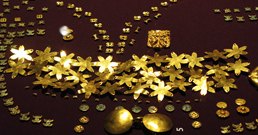The British Museum is currently holding an exhibition entitled Afghanistan: Crossroads of the Ancient World, running until 3 July 2011. It highlights some of the most important archaeological discoveries from ancient Afghanistan and displays precious and unique pieces on loan from the National Museum of Afghanistan in Kabul currently undergoing reconstruction. The geographical position, overland connections and history ensured that it was a region which enjoyed close relations with its neighbours in Central Asia, Iran, India and China, as well as more distant cultures stretching as far as the Mediterranean.
The exhibition showcases over 200 stunning objects belonging to the National Museum of Afghanistan, accompanied by selected items from the British Museum. The artefacts range from Classical sculptures, polychrome ivory inlays originally attached to imported Indian furniture, enamelled Roman glass and polished stone tableware brought from Egypt, to delicate inlaid gold personal ornaments worn by the nomadic elite. Together they showcase the trading and cultural connections of Afghanistan and how it benefited from being on an important crossroads of the ancient world.
All of these objects were found between 1937 and 1978 and were feared to have been lost following the Soviet invasion in 1979 and the civil war which followed, when the National Museum was rocketed and figural displays were later destroyed by the Taliban. Their survival is due to a handful of Afghan officials who deliberately concealed them and they are now exhibited in London in a travelling exhibition designed to highlight to the international community the importance of the cultural heritage of Afghanistan and the remarkable achievements and trading connections of these past civilizations.
The earliest objects in the exhibition are part of a treasure found at the site of Tepe Fullol which dates to 2000 BC, representing the earliest gold objects found in Afghanistan and how already it was connected by trade with urban civilizations in ancient Iran and Iraq. The later finds come from three additional sites, all in northern Afghanistan, and dating between the 3rd century BC and 1st century AD. These are Ai Khanum, a Hellenistic Greek city on the Oxus river and on the modern border with Tajikistan; Begram, a capital of the local Kushan dynasty whose rule extended from Afghanistan into India; and Tillya Tepe, (Hill of Gold), the find spot of an elite nomadic cemetery.
In this multimedia report Dr Omar Khan Masoudi, director of the National Museum of Afghanistan takes us on a tour of the collection on display at the British Museum.
Source: British Museum


